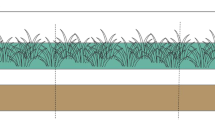Abstract
A novel greenhouse based soil tilting table apparatus was used to investigate the potential for movement of the protozoan pathogen Cryptosporidium parvum both through and across a low permeability soil following the application of contaminated livestock waste to land. Soil blocks supported at an angle of 7.5% by the soil table were inoculated at one end with oocyst seeded slurry and subsequently irrigated at regular intervals over a 70-day period. Movement of the pathogen in runoff was demonstrated for at least 21 days and in one case in excess of 70 days from the time of inoculation. Water was also lost following percolation down through the soil profile and significant numbers of oocysts were also lost via this route, average numbers leached decreasing from 8.36±0.56×106 at day 1 to 2.27±0.73×104 at day 70. At the end of the study cores were removed from the soil blocks to determine the location of oocysts remaining within the soil. Numbers decreased down through the soil profile and as the distance from the point of inoculation increased so that 70 cm from the point of inoculation no oocysts could be detected in the soil at any depth. This implies that oocysts contained in runoff stay in the aqueous phase and do not precipitate out onto the soil surface, suggesting that even if the distances travelled are increased there may still be a significant pollution threat.
Similar content being viewed by others
References
ACDP (1990) Advisory committee on dangerous pathogens. Categorisation of pathogens according to hazard and categories of containment, 2nd edn. HMSO, London
Anon (1990) Cryptosporidium in water supplies — report of a group of experts, chairman — Sir John Badenoch. Department of the Environment, Department of Health. HMSO, London
Baxter-Potter WR, Gilliland MW (1988) Bacterial pollution in runoff from agricultural lands. J Environ Qual 17:27–34
Couillard D, Li JF (1993) Assessment of manure application effects upon the runoff water quality by algal assays and chemical analyses. Environ Pollut 80:273–279
Culley JLB, Phillips PA (1982) Bacteriological quality of surface and subsurface runoff from manured sandy clay loam soil. J Environ Qual 11:155–158
Doran JW, Lin DM (1979) Bacteriological quality of runoff from pastureland. Appl Environ Microbiol 37:985–991
Fernandez-Alvarez RM, Carballo-Cuervo S, de la Rosa-Jorge MC, Rodriguez-de Lecea J (1991) The influence of agricultural runoff on bacterial populations in a river. J Appl Bacteriol 70:437–442
Harvey RW, Kinner NE, Bunn A, MacDonald D, Metge D (1995) Transport behaviour of groundwater protozoa and protozoan-sized microspheres in sandy aquifer sediments. Appl Environ Microbiol 61:209–217
Hendriksen NB (1995) Effect of detritivore earthworms on dispersal and survival of the bacterium Aeromonas hydrophila. Acta Zool Fennica 196:115–119
Jawson MD, Elliot LF, Saxton KE, Fortier DH (1982) The effect of cattle grazing on indicator bacteria in runoff from a Pacific Northwest watershed. J Environ Qual 11:621–627
Khaleel R, Reddy R, Overcash MR (1980) Transport of potential pollutants in runoff water from land areas receiving animal waste: a review. Water Res 14:421–436
MacKenzie WR, Hoxie NJ, Procter ME, Gradus MS, Blair KA, Blair KA, Peterson DE, Kazmierczak JJ, Addiss DG, Fox KR, Rose JB, Davis JP (1994) A massive outbreak in Milwaukee of Cryptosporidium infection transmitted through the public water supply. N Engl J Med 331:161–167
MAFF (1991) Code of good agricultural practice for the protection of water. MAFF Environment Matters, 1991
Mawdsley JL (1994) Movement and viability of the protozoan pathogen Cryptosporidium in three contrasting soil types. In: Pankhurst CE (ed) Soil biota-management in sustainable farming systems. CSIRO Press, Melbourne, pp 87–89
Mawdsley JL, Brooks AE, Merry RJ (1996) Movement of the protozoan pathogen Cryptosporidium parvum in three contrasting soil types. Biol Fertil Soil 21:30–36
Moore JA (1989) Predicting the fate and movement of bacteria in agricultural runoff. In: Dodd VA, Grace DM (eds) Proc 11th Int Cong Agric Eng. Balkema, Rotterdam, pp 311–317
Patni NK, Toxopeus HR, Jui PY (1985) Bacterial quality of runoff from manured and non-manured cropland. Trans ASAE 28:1871–1877
Robertson LJ, Campbell AT, Smith HV (1992) Survival of Cryptosporidium parvum oocysts under various environmental pressures. Appl Environ Microbiol 58:3494–3500
Robertson LJ, Smith HV, Ongerth JE (1994) Cryptosporidium and cryptosporidiosis. Part III: Development of water treatment technologies to remove and inactivate oocysts. Microbiol Europe 2:18–26
Smith HV (1992) Cryptosporidium and water: a review. J Inst Wat Environ Manag 1992:443–451
Thornton ML (1970) Transport of soil-dwelling aquatic phycomycetes by earthworms. Trans Br Mycol Soc 55:391–397
Walker SE, Mostaghimi S, Dillaha TA, Woeste FE (1990) Modelling animal waste management practices: Impacts on bacteria levels in runoff from agricultural lands. Trans ASAE 33:807–817
Author information
Authors and Affiliations
Corresponding author
Rights and permissions
About this article
Cite this article
Mawdsley, J.L., Brooks, A.E., Merry, R.J. et al. Use of a novel soil tilting table apparatus to demonstrate the horizontal and vertical movement of the protozoan pathogen Cryptosporidium parvum in soil. Biol Fertil Soils 23, 215–220 (1996). https://doi.org/10.1007/BF00336066
Received:
Issue Date:
DOI: https://doi.org/10.1007/BF00336066




